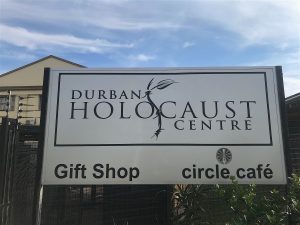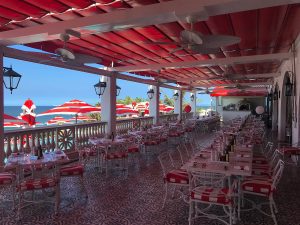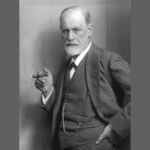When South Africa comes up in conversation, wineries, chic city neighborhoods, beaches, wildlife, and a vibrant arts scene come to mind. This is one of the lasting legacies of Nelson Mandela, who spent his life fighting for a democratic South Africa. It is a legacy shared by members of South Africa’s Jewish community who risked it all to help him achieve that goal.
“The involvement of Jewish community in the anti-apartheid movement was totally disproportionate to their numbers among other whites,” affirmed Derek Hanekom, who spent the formative years of his political career as one of a relatively small number of whites supporting the efforts of the African National Congress (ANC). Even with his arrests and periods of exile in the 70s and 80s, the South African Minister of Tourism and Minister of Agriculture during Nelson Mandela’s presidency stresses, “We had a mass democratic movement, (and within it) there was an organization called Jews for Social Justice, which I believe it is worthy of further study. Why was it that there were so many more Jews involved in the movement than other whites?”
At Indaba, the annual pan-African trade show Hanekom helped anchor, there were tour operators representing seminal historic places like Robben Island (where Mandela was long imprisoned) and the KwaZulu-Natal Freedom Route, tracing the steps of Mandela and Gandhi in their marches toward social change. The show floor brought back memories of my first visit in 2011. After five days at the Kapama Private Game Reserve (outside of Kruger National Park) and two days touring the Western Cape’s “Winelands,” I headed to Robben Island. I had the extreme good fortune of being randomly assigned to former prisoner/guide Sedeeq Levy. He was half-Jewish, half-Muslim, and a master story teller who commented on the prison’s key landmarks, being a non-white minority in a white minority-run country, and his personal conversations with Mandela with a mix of stoicism and wit.
Reflections of the Way Life Used to Be
My college music journalism pursuits in the late 1980s (profiling the late singer/musician Johnny Clegg and Yes-guitarist turned movie composer Trevor Rabin) led me down a rabbit hole of research to learn about other Jewish South Africans who stood up to the dictatorial establishment. First, I read about Lazar Sidelsky, who hired a then 24 year-old Mandela as a clerk in his firm, which paved the way for him to become a lawyer. “In my experience, I have found Jews to be more broad-minded than most whites on issues of race and politics, perhaps because they themselves have historically been victims of prejudice,” Mandela later recalled in his biography, “Long Road to Freedom.”
Although the first South African Jews from England and Germany arrived in the early 19th century, and most can trace their roots to Lithuania, there are interesting parallels with the American Jewish experience. Some Jews emerged as early leaders in South African commerce. Julius, Adolph, and James Mosenthal founded the mohair industry, while Aaron and Daniel de Pass were the largest ship owners in Cape Town, with a hand in the sealing, whaling, and fishing industries. Other Jews found success in ostrich farming and the early diamond industry.
There were still limits in how far most Jews could advance in politics and the military, and instances where they were subject to discrimination. In the 19th century, many Afrikaners viewed Jews as foreigners (“uitlanders”) and excluded them from their mainstream society just as their Christian American counterparts did. The Quota Act of 1930 curtailed the entry of Jews into South Africa, while the 1937 The Aliens Act, driven by a sharp increase in the number of German Jewish refugees coming to South Africa the previous year, brought the migration to almost a complete halt. This parallels the Johnson-Reed Act of 1924, which severely curtailed the number of immigrants from Eastern Europe who would be allowed into the U.S.
“There were still limits in how far most Jews could advance in politics and the military, and instances where they were subject to discrimination.”
As some Afrikaners sympathized with Nazis during the war years, it is no surprise some Jews emigrated from South Africa to Israel, the U.S., Australia, and Canada. However, there were those who followed the courage of their convictions, joining the South Africa Communist Party (paralleling the American experience of Jewish involvement in socialist, communist and anarchist movements both before and after World War Two),putting their lives and freedom at risk. Helen Suzman, perhaps the best-known Jewish anti-Apartheid figure outside of South Africa, brought international attention to Mandela’s plight and goals. At one point, she was his sole white supporter in Parliament, and visited him in prison on eight occasions through her parliamentary privilege.
Joe (Yossel Mashel) Slovo and wife Ruth First also brought awareness to the cause through their writings and organized gatherings, putting themselves in the way of arrests, prosecution, and exile through their lives. One of Slovo’s best-known accomplishments was crafting a power-sharing agreement after the end of apartheid in 1994, making the government’s transition to majority rule smoother.
Other key players included Arthur Goldreich, who used his wealth and social status to covertly raise money for the African National Congress and Liliesleaf, a farm in the Johannesburg suburb of Rivona that was a safe-house for activists (including Mandela) until a tipoff led to a raid in 1963. Nat Bregman, Harold Wolpe, and James Kantor were also part of that circle. Attorney Bram Fischer, meanwhile, was on the defense team in the 1961 Treason Trial and led Mandela’s legal defense team at the 1963 Rivonia Trial. Fischer himself was sentenced to prison for his involvement, and Mandela described him in “Long Road to Freedom” as one of the, “bravest and staunchest friends of the freedom struggle that I have ever known,” sacrificing his freedom and life of privilege yet displaying, “a level of courage and sacrifice that was in a class by itself.”
Activist lawyer Albie Sachs, born into a South African family of Lithuanian Jewish background, is similarly well known. Always recognizable in crowds, Sachs had an arm blown off by a car bomb while in Mozambique due to his opposition to apartheid. After time in the United States, he later returned home and served as a Judge on the Constitutional Court of South Africa where he authored decisions expanding civil rights, equality and dignity.
Small, But Mighty Communities
Although only 50 members of Bloemfontein’s Jewish community remain today (it had 650 families at its peak some decades back), the Jewish Afrikaner was memorialized when Bloemfontein International Airport was officially renamed Bram Fischer International Airport in late 2012. Bloemfontein, which reminded me of several cities in the American South, is still finding its footing as a tourist destination. However, it is rich in historic sites that relate to the greater scope of South African history. One thing not obvious right off that bat, however, is that in the 19th century several Jewish families and entrepreneurs contributed to the city’s development and counted three Jews among its mayors.
Cape Town, in contrast, is the consummate destination city awash with colorful stand-alone neighborhoods, famous restaurants, prestige wineries within driving distance, and beachfronts. In other words, a pretty mashup of San Francisco, Napa, and San Diego through a European lens. Beyond the natural wonder of Table Mountain, Cape Town’s heart and soul is rooted in the visual and performing arts. Highlights include the Crypt Jazz Restaurant (in the basement of St. George’s Cathedral, which also contains Archbishop Desmond Tutu’s memorial and installations commemorating landmark anti-Apartheid demonstrations), the breathtaking Zeitz Museum of Contemporary Art Africa, and the Woodstock district’s vibrant murals and weekend “Neighbourgoods Market.”
 For this reason, Jewish points of interest have to be just as visually and contextually interesting—and they are. The Cape Town Holocaust and Genocide Centre, which has sister museums in Durban and Johannesburg, displays artifacts and audio visual exhibits detailing personal stories of Jewish holocaust survivors who settled in Cape Town. The South African Jewish Center, meanwhile, is laser-focused on the South African Jewish experience, from an impressive recreation of a Lithuanian shtetl to the preservation of South Africa’s first synagogue, to space dedicated to the Jewish heroes of the anti-Apartheid movement and its ties to Israel (Abba Eban, Foreign Minister of Israel from 1966-1974, is a Cape Town native).
For this reason, Jewish points of interest have to be just as visually and contextually interesting—and they are. The Cape Town Holocaust and Genocide Centre, which has sister museums in Durban and Johannesburg, displays artifacts and audio visual exhibits detailing personal stories of Jewish holocaust survivors who settled in Cape Town. The South African Jewish Center, meanwhile, is laser-focused on the South African Jewish experience, from an impressive recreation of a Lithuanian shtetl to the preservation of South Africa’s first synagogue, to space dedicated to the Jewish heroes of the anti-Apartheid movement and its ties to Israel (Abba Eban, Foreign Minister of Israel from 1966-1974, is a Cape Town native).
If Cape Town has a sensibility comparable to America’s West Coast, Durban is its East Coast/Miami counterpart. What makes Durban particularly worthwhile is its compelling mix of cultures, resulting in an interesting mix of cuisines, architecture, and neighborhoods. The city’s primary Jewish site, the Durban Jewish Holocaust and Genocide Centre, is relatively easy to find with its location five minutes from the colorful North Beach waterfront.
Mary Kluk, the center’s director, points out that while there were 120,000 Jews in South Africa in the 1970s, 70,000 remain. Durban’s Jewish roots run deep, with third, fourth, and fifth Jewish generation staying on. The museum, café, bookshop, and library occupies the former Jewish Club in Central Durban, which opened in 1931 in response to local country clubs that did not welcome Jews. Beyond this site, the greater community oversees a senior citizen’s home with100 residents, social welfare office, and sheltered workshop with a residential component for disabled community members.
“We number about 2,000 souls, (but) we are a thriving community which belies this small number,” she affirms. “I love the intimacy of the small community, and the sense of commitment we have for one another. There are many advantages to raising a family in a small community like ours, where we can readily pass on our values and sense of obligation on to the next generation. With a community this size, it is easier for members of all ages to play a part. What we all get in return is a very meaningful sense of belonging.”
Durban’s Jewish community has been gravitating north in recent years to the upscale Umshlanga Rocks area. Its JCC and synagogue opened seven years ago in response to the population shift, with a Mikva and day school with secular and religious education. Kluk adds that there is a Jewish studies program allowing kids and teens attending schools in the city to live a Jewish life within the space of a secular school.
 The Oyster Box Hotel, one of Durban’s most fashionable addresses, is another Jewish destination worth exploring beyond its lush décor, art collection, and prodigious curry buffet. The current owners, hoteliers Stanley and Bea Tollman, are continuing traditions and practices established by earlier generations of South African Jewish business leaders. The heads of the international Red Carnation Hotels (which also counts properties in Cape Town, Ireland, England, and South Florida) were selected to buy the property as the previous owners who wanted their successors to maintain it as a “family business.” In many respects, the 65 year-old property the Tollmans and their team lovingly restored has long been a part of their family, starting from the time the couple were regular visitors and got engaged there.
The Oyster Box Hotel, one of Durban’s most fashionable addresses, is another Jewish destination worth exploring beyond its lush décor, art collection, and prodigious curry buffet. The current owners, hoteliers Stanley and Bea Tollman, are continuing traditions and practices established by earlier generations of South African Jewish business leaders. The heads of the international Red Carnation Hotels (which also counts properties in Cape Town, Ireland, England, and South Florida) were selected to buy the property as the previous owners who wanted their successors to maintain it as a “family business.” In many respects, the 65 year-old property the Tollmans and their team lovingly restored has long been a part of their family, starting from the time the couple were regular visitors and got engaged there.
In Johannesburg, the nation’s largest city, The Saxon Hotel is not only one of the city’s most refined lodgings, but also one of the most accommodating for Jewish families. It helps that its executive director, Anton Gillis, is a Jewish South African personally invested in providing guests at all levels of observance an authentic experience as well as a luxurious one.
 “I am fortunate to have been brought up with Jewish values and a strong sense of tradition and Zionism,” says Gillis, a Cape Town native educated in the local Herzlia School system. “In South Africa, we have a strong sense of Jewish identity, and are fortunate to have a wide selection of Synagogues to choose from as well as a healthy and diverse Rabbinic body. As I am blessed to be married with a son, Kai Ariel, my wife Taryn and I have no plans to leave South Africa as we live great lives here.”
“I am fortunate to have been brought up with Jewish values and a strong sense of tradition and Zionism,” says Gillis, a Cape Town native educated in the local Herzlia School system. “In South Africa, we have a strong sense of Jewish identity, and are fortunate to have a wide selection of Synagogues to choose from as well as a healthy and diverse Rabbinic body. As I am blessed to be married with a son, Kai Ariel, my wife Taryn and I have no plans to leave South Africa as we live great lives here.”
He says the first step for interested guests is to reach out to him in advance to curate a stay integrating observance needs with the offerings of the hotel or its sister safari property, Shambala Private Game Reserve.
“I will introduce the guests to a respective Rabbi, depending on their preference, especially as Johannesburg has many beautiful Synagogues, each uniquely special in their own way,” Gillis continues. “Should they be Shomer Shabbat, we can arrange private security to accompany the guests on foot and or in a vehicle. I can also arrange a Shabbat dinner or lunch with a local family, especially as Sandhurst is a safe suburb whereby Jews can walk around with Kippot proudly.”
“It is an interesting question,” says Kluk on why the Jewish population is shrinking even as the standard of living is still excellent. Our meeting happened to be on South Africa’s election day, and the public was voting on candidates and measures based on a completely different set of problems from those 30 years earlier.
“The routine answer is that it is not an easy decision to stay or go, as there are so many hard issues either way. As I see it, you are brave if you go and you are brave if you stay. For those of us who stayed, it was a challenging journey for us as a part of that transition to democracy. Our being a minority in our own right has its challenges. While the choice to stay was not for everybody, I found being witness to the birth of this democracy was exciting and makes me proud to be a South African Jew.”
Other useful information:
South African Tourism: southafrica.net/us/en/
The South African Jewish Board of Deputies (sajbd.org) publishes the “Jewish Guide to South Africa,” with comprehensive listings of synagogues, community groups, kosher food sources, and other useful information covering the entire country. The website publishes articles on current events affecting the Jewish communities in towns across the country.
Author’s Note: While there remain many questions and concerns about the safety of travel domestically and abroad at press time, my editors and I hope this story will provide inspiration on how you can plan for interesting, enlightening and responsible journeys in the future once circumstances allow for travel with confidence—such as increased availability of a vaccine or the dramatic slowing of new cases over the next few months. In the meantime, be sure to regularly consult sites such as the U.S. State Department (state.gov), the Centers for Disease Control (cdc.gov) and the official tourism offices and government sites of your intended destination.







